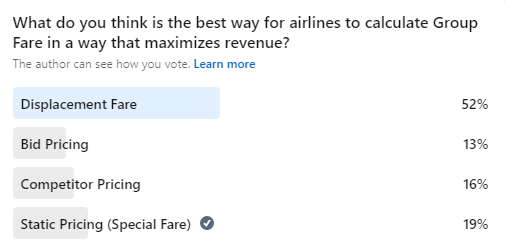Every group request that reaches the airline sales desk is unique, but they all must go through the same gruelling and manual process to get their tickets confirmed.
What ensues is countless hours wasted for the airline and the customers, both retail and travel agents, who end up choosing another airline. About 81% of passengers reported they pick the airline that comes up with the fastest quote.
As a result, group booking customers abandoning their booking midway is a serious issue that costs airlines millions.
Passengers are also more likely to stick with airlines that offer them the ability to customize their group booking requests with ancillaries, payment methods, etc.
Even those who take the flight end up dissatisfied due to the various customization challenges in the manual group booking process and pick another carrier.
So, it turns out providing a truly digital customer experience for group booking passengers is the way to go when it comes to increasing airline revenue, as travel volumes pick up around the world.
The bane of manual, less exciting, and inflexible group booking processes
Notably, the group booking process hasn’t changed much in the last decade, primarily because airlines have not seen group bookings as the true powerhouse of revenue generation that they are.
Group requests—whether they are ad-hoc requests from retail customers, series requests from travel agents, or MICE (meetings, incentives, conferencing & exhibition) based requests from corporates, wedding planners, event organizers, etc.— all have the potential to increase airline load factor and the bottom-line as well.
But optimizing group revenue has been an arduous task for airlines.
This has largely been the case due to group bookings’ unappealing and tiring nature.
Customers typically place a group request on the airline website and wait for a week to get a quote. Then comes the cumbersome process of negotiating the group fares via phone or email.
Add the hurdles associated with customizing each ticket in the group request with ancillaries, class, etc., and you end up with a process that will turn even the most patient of people away from the booking process.
It doesn’t stop there; passengers must wait for a few more days for the payments to go through and generate the PNR.
Then, to make matters exponentially worse, the manual process presents a huge hurdle for groups that need to change aspects of the booking, such as the number of tickets, passenger name, etc.
The transformative power of “the shopping experience”
Just as Amazon and Netflix have transformed their respective spaces by providing an AI-driven shopping experience, airlines can make the process of group booking a delightful experience that also brings in optimal revenue.
Airlines need to start by using an automated group booking solution that allows customers to make different group requests.
For instance, a travel agent who wants 10 tickets to London from Paris every Wednesday for the next three months will have vastly different needs than a corporation that wants to treat its board members to a week-long paid vacation in the Bahamas.
When airlines provide customized booking options to different groups, they will undoubtedly see a consistent spike in revenue, just as a Southeast Asian airline saw a whopping growth in revenue from 0 to $1.5M in 3 months from retail groups alone.
Ideally, airlines also need to allow customers to have unique group policies, such as the time required for updating passenger names, changes to the number of tickets, the time to be taken for making payments, etc.
Another way airlines can provide a memorable shopping experience for customers is by providing quotes in real-time using AI, in the same way, that you get a quote when you place something in your Amazon shopping cart. The group booking solution’s algorithm will ensure that the quote is optimal after considering crucial factors, including competitor fares, customer buying behavior, load factor, etc. This ability to offer dynamic pricing has improved the group fare of low load factor flights by 2%.
It is worth mentioning that customers will be able to negotiate and make the entire booking through a single portal, instead of sending countless emails and calling up the sales team many times, only to hear from a different person each time.
Revenue optimization doesn’t have to stop here. Just as Amazon and Alibaba, and other shopping websites throw up personalized recommendations when customers are ready to checkout, airlines can present customers with ancillaries that add to their bottom line.
Group booking solutions can further allow ancillary customization for each passenger in the group request, such as lounge access, travel insurance, Wi-Fi, food, etc., prioritizing customer experience.
What’s more, customers can provide their names to the airline directly and have their tickets issued automatically to them, rather than waiting for all the others in the group to confirm that they’re taking the trip. Undoubtedly, this will remove the hassle of raising name change requests manually through a single person in contact with the airline.
Crucially, airlines will also be able to fill more seats and improve revenue substantially with the automated follow-up feature for both payments and updating the names of passengers.
Conclusion
Group bookings are a vastly untapped market, so airlines that are first to realize the importance of automating the process and providing a shopping experience for customers stand to gain a lot in the coming years.
With GroupRM, airlines have observed group materialization rates skyrocketing by 50%. If you are interested in knowing more about how GroupRM will help you retain more group passengers by providing them a seamless booking experience, Reach us for a demo











